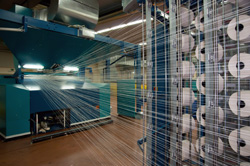Smart machines and revitalised textiles
The European textile sector turns over EUR 200 billion annually, employing 2.5 million people in over 150 000 businesses. However, Far Eastern manufacturers are strongly competitive in this market. Various reasons explain this, one being the easily copied traditional designs of European textile-manufacturing machines. More sophisticated machines, producing new fabrics, are required. Such were the goals of the EU-funded NU-WAVE project. The project was conceived to support the MANUTEX Strategic Research Agenda (SRA) by designing a new generation of high-performance textile machines. Partners had three main goals: to characterise and include advanced materials into machines, to develop new mechatronics designs and to develop virtual prototyping software. The initial scenario analysis consisted of surveys of patents and the research literature, and collection of other technical information. This led to a focus of design efforts on friction reduction and wear resistance, reduction of noise and vibration, mechatronics, computer-aided engineering and energy savings. These aspects were incorporated into the three demonstrator prototype systems the project produced during the design and testing phases, as follows. A crochet loom was improved with modified actuation systems for weft bars, plus a new weft bar design. This demonstrator also incorporated new mechatronics and control algorithms, plus novel coatings and lightweight materials for its core mechanisms. A wear resistance testing stand was developed as rough yarn moving at high speeds through machines can cause extreme wear, which reduces fabric quality and increases costs. Thus, this prototype included new ceramic materials and/or new metal coatings for high-wear components. Typically, dyeing can be slow and labour-intensive. NU-WAVE developed new control sensors and algorithms that allow modularity of the yarn dyeing machine as well as fast adaptation and optimisation of the colouring process. The speed improvements will increase plant performance and flexibility. The three prototypes, and the systems they demonstrate, were well received at a 2011 trade fair. The overall project result will be better manufacturing machines, meaning better fabrics and increased productivity. That should mean improved competitiveness and greater profitability for the European textile industry.







